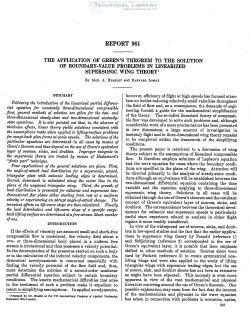naca-report-961

- Version
- 172 Downloads
- 1.25 MB File Size
- 1 File Count
- September 1, 2016 Create Date
- September 1, 2016 Last Updated
National Advisory Committee for Aeronautics, Report - The Application of Green's Theorem to the Solution of Boundary Value Problems in Linearized Supersonic Wing Theory

Following the introduction of the linearized partial dweren-
tial equation. for nonsteady three-dimensional compressible
flow, general methods of solution are giten for the two- and
three-dimensional steady-state and two-dimensional unsteady-
state equations. It is also pointed out that, in the absence of
thickness efects, linear theory yields solutions consistent with
the assumptions made when applied to lifting—surface problems
for swept-back plan forms at sonic speeds. The solutions of the
particular equations are determined in all cases by means of
Green’s theorem and thus depend on the use of Green’s eguimlent
layer of sources, sinks, and doublets. Improper integrals in
the supersonic theory are treated by means of Hadamard’s
“finite part” technique.
Four applications of the general solutions are given: First,
the angle-Qf-attaclr load distribution for a supersonic, ya-wed,
triangular plate with subsonic leading edges is determined-
Second, downwash is calculated along the center line in the
plane of the unyawed triangular wing. Third, the growth of
load distribution is presented for subsonic and supersonic two—
dimensional flat plates either starting from rest at a uniform
velocity or erperiencing an abrupt angle-of-attaclc change. The
transient ejects on lift—curse slope are then calculated. Finally
the load distribution and lift-curve slope of a- specific swept-
baclc lifting surface are determined at afree—stream Adach number
of one.
If the effects of viscosity are assumed small and shock-free
compressible flow is considered, the velocity field about a
two- or three-dimensional body placed in a uniform free
stream is irrotational and thus possesses a velocity potential.
In the determination of the pressures exerted on such a body
or in the calculation of the induced velocity components, the
theoretical aerodynamicist is concerned essentially with
finding the velocity potential of the flow field and, thus,
must determine the solution of a second-order nonlinear
partial differential equation subject to certain boundary
conditions. The known mathematical diElculties that arise
in the treatment of such a problem make it expedient to
resort to simplifying assumptions.
| File | Action |
|---|---|
| naca-report-961 The Application of Green's Theorem to the Solution of Boundary Value Problems in Linearized Supersonic Wing Theory.pdf | Download |

Comment On This Post